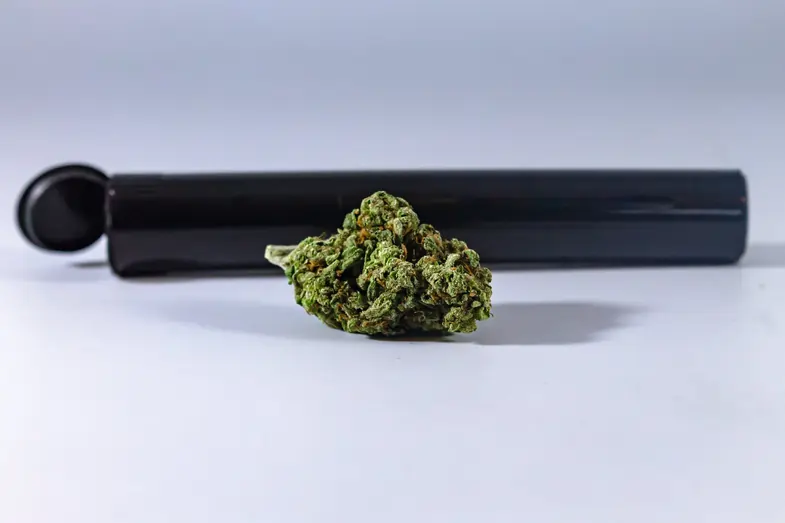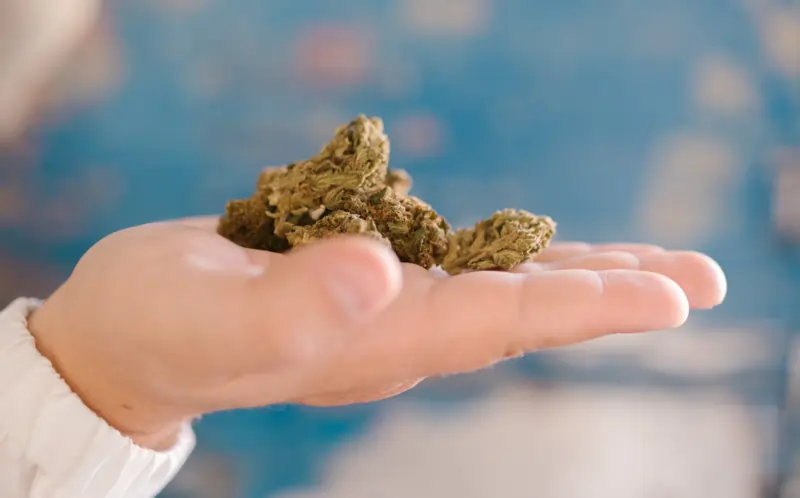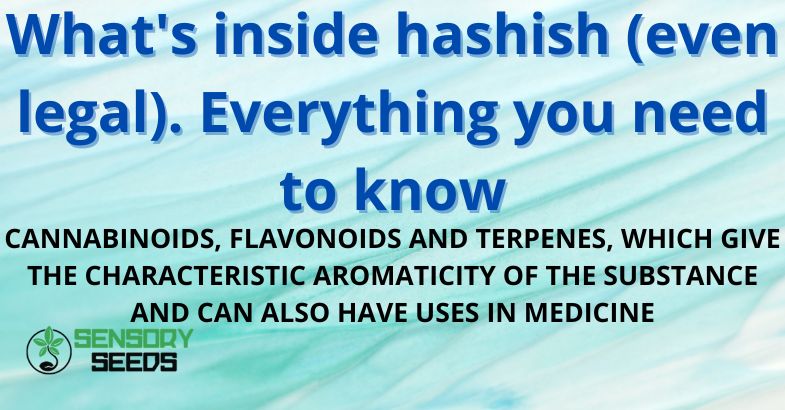Published on: 15/03/2024
CANNABINOIDS, FLAVONOIDS AND TERPENES, WHICH GIVE THE CHARACTERISTIC AROMATICITY OF THE SUBSTANCE AND CAN ALSO HAVE USES IN MEDICINE
Hashish is a cannabis derivative well known since ancient times, a compact substance obtained from the resin of female hemp plants, to be precise from the trichomes, the glands that produce and contain cannabinoids and terpenes.
This substance, which varies in color from gold to black or reddish and can have consistencies ranging from pasty to semi-solid, has played – and still plays – a significant role in several cultures: over time, it has been used for ritual, healing and even “playful” purposes.
The oldest and most widespread method of resin extraction involved the drying and subsequent processing of cannabis buds. There are several other extraction methods, such as burbuka (Afghan, Moroccan, Nepalese), charas (Indian) and bubble hash, each with specific techniques that influence the characteristics of the final product.
In recent years, the concept of “legal hashish” has gained some popularity, thanks to cannabis varieties with high CBD (cannabidiol) content and low THC (tetrahydrocannabinol) content, the main psychoactive substance in cannabis. Legal hashish retains the aromatic and texture characteristics of traditional hashish, but lacks the psychotropic effects associated with THC.
National legislation regulates the use of hashish, with some countries having established specific limits on the THC content allowed to consider the product legal. In the UK, for example, hashish is considered legal if it contains less than 0.6% THC, a criterion established by law 242/16 which regulates the production and sale of hemp-derived products. Last August, a ministerial decree included CBD among the narcotic substances, a decree later suspended by the TAR for illegitimacy.
However, there are quite a few enthusiasts who collect cannabis seeds purely for collectors’ sake, a sign that hashish and cannabis have entered popular culture around the world.
Hashish continues to be studied for its effects and potential therapeutic applications. CBD, especially, is much studied for possible health benefits.
But specifically, what is in hashish, legal and otherwise? Let’s delve deeper into the topic.
Read also: Why does cannabis cause red eyes?
What is hashish made of?
Hashish is a resin rich in cannabinoids, terpenes and flavonoids, elements that give the substance its well-known psychoactive, therapeutic and aromatic properties. Its chemical composition is complex, deriving directly from the trichomes of female cannabis inflorescences, which are responsible for the production of the compound.
Tetrahydrocannabinol (THC) is the main psychoactive component of hashish, known for its psychoactive effects. However, hashish also contains cannabidiol (CBD), a non-psychoactive cannabinoid valued for its potential therapeutic properties, such as anti-inflammatory, anxiolytic, and pain-relieving effects. The proportion of THC and CBD can vary considerably depending on the variety of cannabis used and the extraction method, directly influencing the effects produced by hashish.
Speaking of legal hashish, the distinction becomes relevant: to be considered as such, the product must contain THC levels lower than the limits established by law; at the same time, it must contain high concentrations of CBD. This chemical balance allows legal hashish to offer the benefits of CBD without the psychoactive effects associated with THC, making it a product suitable for uses that can range from personal well-being to therapeutic applications.
In addition to THC and CBD, hashish contains a wide range of other cannabinoids in smaller quantities, as well as terpenes, aromatic compounds that give cannabis its characteristic aroma and flavor. Terpenes not only enrich the consumer’s sensory experience but, according to science, could have potential synergistic effects with cannabinoids (the so-called entourage effect).
In summary, the composition of hashish is a complex mosaic of chemical substances that define its identity and effectiveness. Whether it is “traditional” or legal hashish, understanding its composition is essential to fully appreciate its potential and navigate its use with awareness.
Read also: THC and CBD microdosing: everything you need to know about it


How hashish is produced
As mentioned, the production of hashish is an artisanal and at the same time technological process that involves the extraction of the resin from cannabis, concentrating its active ingredients. It is a process that has deep historical roots and varies based on cultural traditions, available technology and the species of cannabis used.
One of the oldest and most widespread methods is burbuka, which involves varieties such as Afghan, Moroccan and Nepalese hashish. This technique involves dry sieving of the dried inflorescences to separate the trichomes, which are pressed to form the hashish: this enhances the purity of the resin, maintaining a high concentration of active ingredients.
Charas or Indian hashish represents another traditional technique, which stands out for the manual extraction of resin from still fresh plants. This is a very laborious procedure, which requires some skill to collect the trichomes directly by rubbing the flowers between your hands. Charas is particularly appreciated for its aroma and its soft texture.
Innovation in hash production manifests itself in bubble hash or ice wax, a modern technique that uses ice water to separate trichomes from plant matter. This method uses temperature to make the trichomes more fragile and therefore easier to filter through fine mesh bags, called Bubble Bags. The result is a product of the highest purity, free of plant contamination.
The production of legal hashish follows similar principles, with attention paid to the selection of cannabis varieties that respect legal THC limits. This aspect is fundamental to ensure that the finished product can be marketed legally, while still maintaining a high content of CBD and other non-psychoactive cannabinoids.
Hashish production is a fusion of ancient traditions and modern innovations, with methods that vary widely depending on the needs of the producer and the preferences of consumers. Whether it is traditional techniques or cutting-edge processes, the objective remains the same: to concentrate the active ingredients of cannabis in a product that best expresses the potential of the plant
The effects of hashish and its use
Hashish, as mentioned, has a long history of use for recreational, spiritual and therapeutic purposes. The main effects are THC (tetrahydrocannabinol) and CBD (cannabidiol), as well as other cannabinoids and terpenes. These components work together, influencing a wide range of bodily and mental functions.
THC is known for its psychoactive effects, which may include euphoria, relaxation, altered sensory perception and time, as well as potential side effects such as anxiety or paranoia in some users. On the contrary, legal hashish, with its low THC content, aims to minimize these psychoactive effects and represents an alternative for those seeking the benefits of the substance without altering their mental state.
CBD is prized for its relaxing, anti-inflammatory and analgesic effects. Interest in legal hashish and other CBD products is growing, especially among those seeking relief from conditions such as anxiety, chronic pain, inflammation and sleep disorders, among others.
In addition to recreational uses, hashish has often been used for medicinal practices and religious rituals in several cultures.
The effects and use of hashish vary widely depending on the chemical composition and individual response. Legal hashish is an opportunity to explore the benefits of cannabinoids with a reduced risk of side effects, but as with any active substance, an informed and measured approach is key.
Difference between THC and CBD
Understanding the difference between THC and CBD helps to orient oneself in the increasingly varied panorama of cannabis-based products and to understand the effects that these compounds have on the body.
THC: the psychoactive effects of the substance
THC is the main psychoactive agent present in cannabis, responsible for the euphoric effects. This cannabinoid interacts with the body’s endocannabinoid system, influencing functions such as mood, memory, appetite, and pain. Despite its recreational use, THC is also valued for its potential therapeutic properties, such as pain relief and appetite stimulation. However, its consumption can lead to serious side effects such as anxiety, paranoia and alteration of cognition, especially at high doses.
CBD: therapeutic benefits without psychoactivity
CBD has been studied for its anti-inflammatory, anxiolytic, anticonvulsant and pain-relieving properties. It is used to treat anxiety, epilepsy, chronic pain and sleep disorders. The growing popularity of CBD is reflected in the diversification of products available on the market, including those derived from legal hashish, which promote general well-being without psychotropic effects.


Types of legal hashish
The legal hashish landscape today offers various types of products that meet the needs and tastes of an increasingly informed and varied public, developed to maximize the benefits of CBD (cannabidiol) and other non-psychoactive cannabinoids, minimizing or completely eliminating the THC (tetrahydrocannabinol) to stay within legal limits.
Charas CBD
Charas is a type of hashish produced manually in India and Nepal. This traditional technique involves harvesting resin by directly rubbing fresh cannabis flowers between your hands. The legal version of Charas uses plants with high CBD and low THC content, maintaining artisanal production techniques to offer a unique product, rich in aroma and relaxing properties, without psychoactive effects.
Bubblehash
Bubblehash represents excellence in the legal hashish segment: it is obtained through a process that uses ice water to separate the resin from the plant matter. This method produces high-quality hash with a significant concentration of CBD. The purity and potency of Bubblehash make it particularly appreciated for its therapeutic profile.
Legal hashish based on extracts
As extraction techniques have advanced, new types of legal hashish have emerged that use sophisticated methods to isolate and concentrate the desired cannabinoids and terpenes. These products often incorporate pure CBD extracts into a hash resin base, creating a rich, multi-dimensional user experience that enhances both the flavor and therapeutic effects of cannabidiol.
Innovations and Trends
The legal hashish industry continues to evolve, with producers experimenting with crossbreeding and advanced cultivation techniques to develop hemp strains increasingly rich in CBD and other minor cannabinoids
The types of legal hashish available on the market reflect the ever-increasing diversification and specialization of the sector. From the traditional craftsmanship of Charas to the technological precision of Bubblehash and extracts, legal hashish offers options for every preference, promoting responsible and informed consumption within a clear and defined legal framework.
If you are an enthusiast, in our store you can find seeds from collections of all types, from fast flowering seeds to feminized seeds, the ideal choice to enrich your collection.
In conclusion
Hashish is essentially composed of a mixture of cannabinoids, terpenes and flavonoids and can offer an experience that varies greatly based on its chemical composition and production method.
In production, tradition is accompanied by innovation, with techniques ranging from burbuka and charas to the most modern ice water-based extractions, which reflects a continuous evolution in the search for purity and effectiveness.
The growing interest in legal hashish coming from marijuana seeds, characterized by a balance between low levels of THC and high concentrations of CBD, highlights a change in consumer preferences, now oriented towards products that offer therapeutic benefits without the psychoactive effects traditionally associated with cannabis.
The distinction between THC and CBD is fundamental to understanding the effects and applications of hashish. While THC dominates for its psychoactive effects, often sought for recreational use, CBD is a component of great interest for its therapeutic properties. This dualism reflects the dual nature of hashish: on the one hand, a source of pleasure and sensory discovery; on the other, a potential ally in the management of disorders and pathologies.
Hashish, with its complex composition, is a substance that can have interesting applications: in-depth knowledge of its components and effects can help understand its potential in various fields.
Takeaways
History and culture: Hashish is a substance with a long history, used in various cultures for ritual, healing and recreational purposes. Its production and consumption have evolved over time, reflecting its importance in both tradition and modern society;
Composition and effects: composed mainly of THC, CBD, terpenes and flavonoids, hashish offers a wide range of effects that vary depending on its chemical composition. While THC is responsible for psychoactive effects, CBD is sought after for its potential therapeutic properties, ranging from anti-inflammatory to anxiolytic effects;
Legal hashish: The introduction of legal hashish, characterized by a high CBD content and a low THC content, marks a significant change in the way this substance is perceived and used. This type of hashish aims to offer the therapeutic benefits without the psychoactive effects associated with THC, responding to the needs of a public looking for natural alternatives for personal well-being;
Production Methods: Hashish production varies widely, from traditional methods like burbuka and charas to modern techniques like bubble hash. This diversity in production methods reflects not only cultural traditions but also innovation in the field, with the aim of improving the purity and effectiveness of the final product;
Legislation and popular culture: Regulation of hashish varies significantly depending on national context, reflecting a broad spectrum of attitudes towards its legality and use. Despite legal challenges, hashish and cannabis in general have gained a place in popular culture, highlighting a shift in social acceptance and interest in its therapeutic and recreational potential.
Frequent questions
What does hashish contain?
Hashish is rich in cannabinoids, terpenes and flavonoids, which give it psychoactive, therapeutic and aromatic properties. THC (tetrahydrocannabinol) is the main component for psychoactive effects, while CBD (cannabidiol) is known for its potential therapeutic properties.
How is hashish produced?
Hash production varies from traditional methods such as burbuka and charas to modern techniques such as bubble hash. These methods are based on the extraction of resin from cannabis inflorescences, with variations that influence the purity and concentration of the active ingredients.
What is the difference between THC and CBD?
THC is the main psychoactive agent in cannabis, responsible for the euphoric effects. CBD, in contrast, is studied for its anti-inflammatory, anxiolytic, anticonvulsant and pain-relieving properties, offering therapeutic benefits without the psychotropic effects of THC.









